Garbage Collectors in JVM-based languages

In this topic I would like to talk about garbage collectors (GCs). The aim that I target is to give a brief overview of main concepts of Garbage Collectors and list available GC implementations.
Contents
- What is Garbage Collector?
- Serial Garbage Collector
- Parallel Garbage Collector
- Concurrent Mark Sweep (CMS) Collector
- G1 - Garbage First Collector
- ZGC - The Z Garbage Collector
- ShenandoahGC
- Azul C4 Garbage Collector
- Epsilon Garbage Collector
What is Garbage Collector?
Garbage Collector is a form of automatic memory management
— Wikipedia
The component takes care about reclaiming memory that was allocated for objects needed earlier. There are programming languages that don’t provide this functionality and a programmer has to manage memory manually.
Java Virtual Machine (JVM) includes garbage collector. It means that all JVM-based languages e.g. Java, Kotlin, Scala, Clojure supports automatic reclaiming unused objects.
There are many algorithms that might be applied to check if an object is not needed and
memory for the object might be reused for other objects. The main idea of them is if there are no references
to an object, the object is unreachable and can’t be used. By this way, this type of objects might be deleted safely.
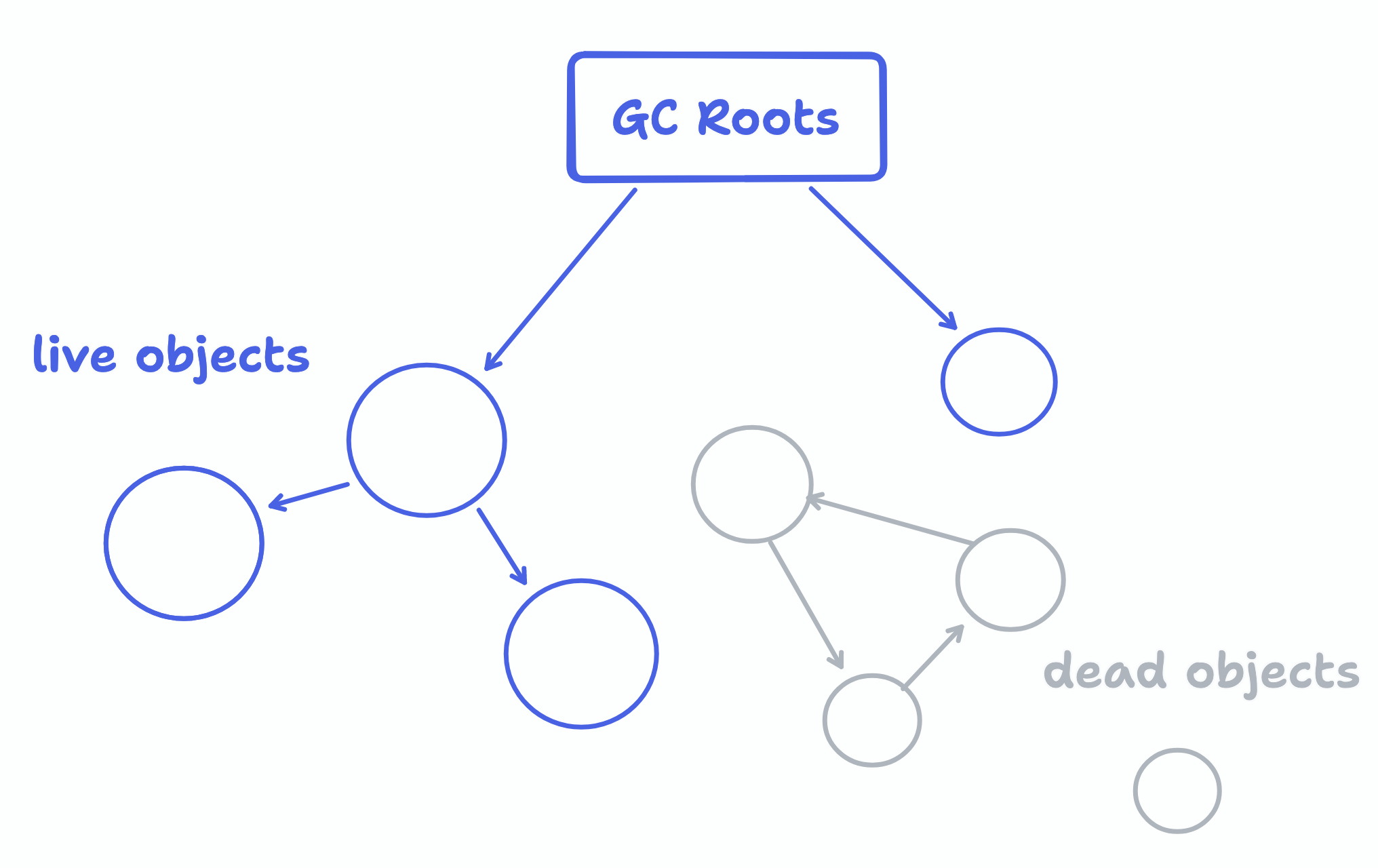
Garbage Collector traverses the reference graph from the several start points. They are called GC Roots. It might be static variables, classes loaded by system class loaders, active threads etc.
There are some common phases of the GC work that encounter in listed below garbage collectors:
- Identify live objects that are reachable from the GC Roots
- Reclaim memory held by dead objects
- Relocate live objects or compact them
Let’s talk about what type of garbage collectors you can use if you write code in JVM-based language.
Serial Garbage Collector
It’s one of the oldest garbage collector and exists from the first version of JVM. Serial Garbage Collector works simply. All running threads are suspended and all references are checked by one thread. It occurs stop-the-world pause.
To enable the GC, use the following command:
java \
-XX:+UseSerialGC # enable Serial Garbage Collector
Parallel Garbage Collector
Based on the name, you might guess how it works. The Parallel Garbage Collector works as Serial Garbage Collector works, but we can set number of threads. By this way, the total stop-the-world pause must be less if garbage collector works in multi-thread mode.
There are several JVM flags that works with Parallel Garbage Collector.
java \
-XX:+UseParallelGC # enable Parallel Garbage Collector
-XX:MaxGCPauseMillis=<N> # maximum time interval between GC
-XX:GCTimeRatio=<N> #the ratio between GC time and time of execution application
-XX:ParallelGCThreads=<N> # number of threads
Concurrent Mark Sweep (CMS) Collector
The idea behind a work of the garbage collector is The Weak Generational Hypothesis. It says
Objects will die young
i.e. the longer an object lives, the longer it will be reachable.
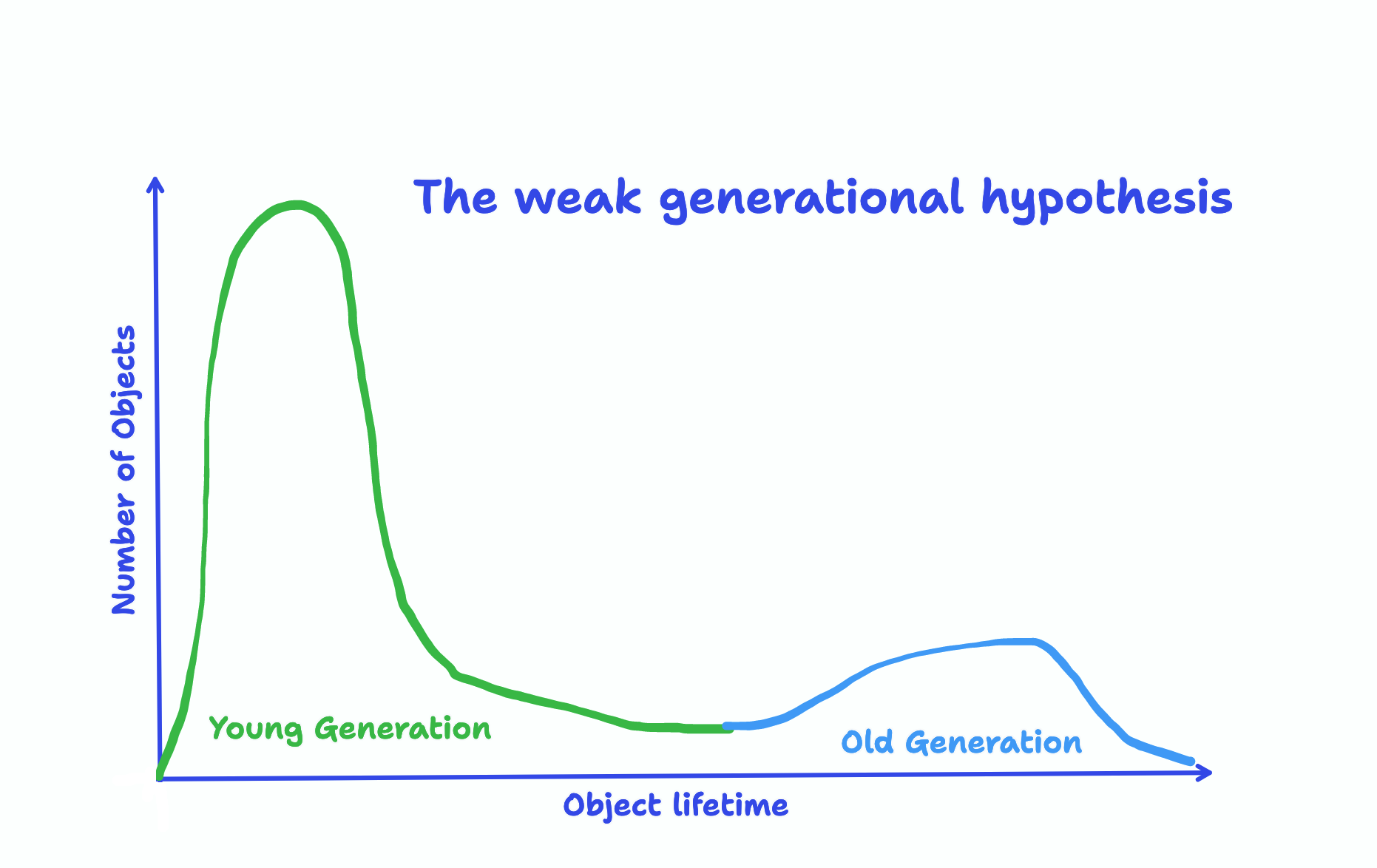
By this way, there is no need of scanning the whole set of objects. If memory is split into different categories and check them separately, it might be possible to reduce the stop-the-world pause by scanning regions of memory at different rates.
CMS Collector works in pretty the same way. All memory is split into 3 regions:
- Permanent Generation
- Young Generation
- Old Generation
Permanent Generation is a memory region where JVM locates static data e.g. loaded classes metadata, static methods, static variables.
Young Generation is a segment where JVM allocates memory for a new objects. After several GC collections, if an object is still alive, it will be moved to Old Generation.
Old Generation is memory region where “old” objects are located. At some point, object might be placed there directly if capacity of Young Generation doesn’t let do it.
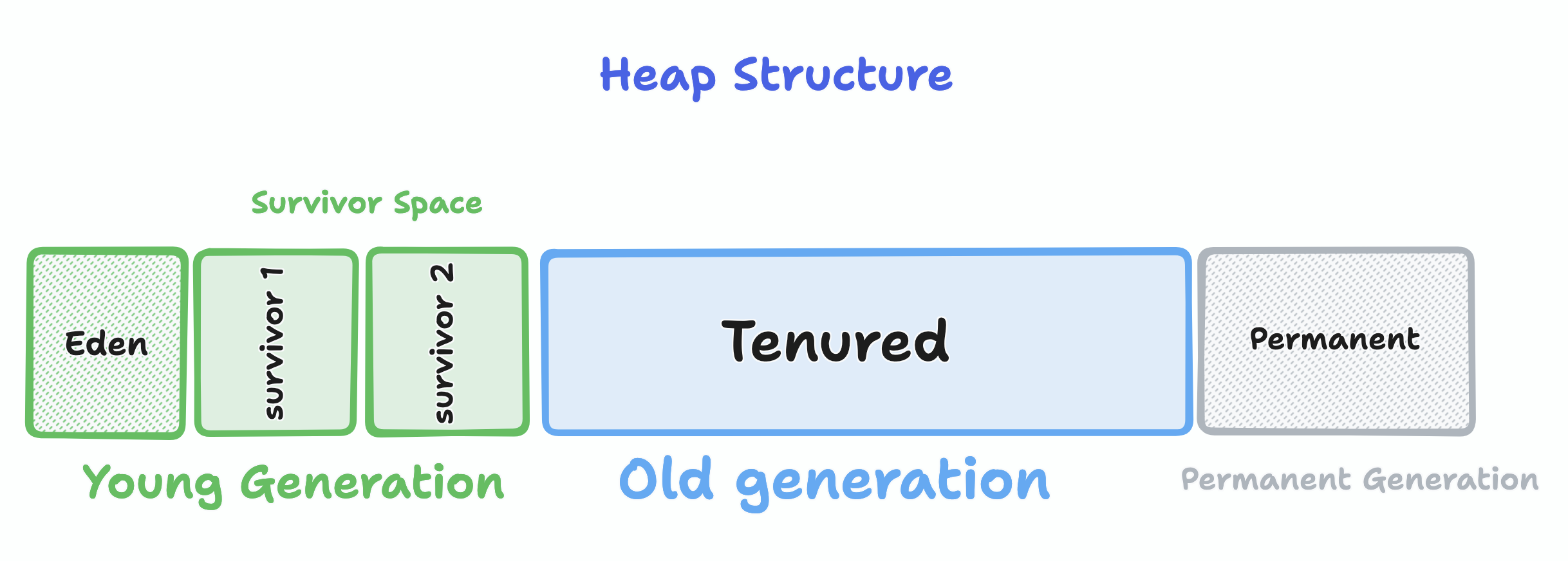
This garbage collector is a combination of two previous ones. Serial Garbage Collector and Parallel Garbage Collector get on the stage at different time.
Initially, Parallel Garbage Collector pauses application threads twice. At initial pause
it marks objects that are reachable from the GC Roots as live. Then Parallel Garbage Collector traces
the available references concurrently and identifies reachable objects without suspending application threads.
Since application is running during this step, checked references might be changed. That’s why Parallel Garbage Collector needs the second remark pause.
After it, all objects that aren’t reachable might be removed and live objects are compacted. This operation happens during Concurrent Sweep phase.
When Old Generation becomes full Serial Collector starts working. In this case, all application threads are stopped while collection is done.
There are several JVM flags that might come in handy to work with CMS Collector:
java \
-XX:+UseConcMarkSweepGC # enable Concurrent Mark & Sweep Garbage Collector
-XX:ConcGCThreads=<N> # total count of threads for GC
-XX:+CMSScavengeBeforeRemark # run remark stage after GC execution on new generation area
-XX:CMSWaitDuration # run GC on tenured are after GC execution on new generation
-XX:ParallelGCThreads=<N> # count of threads for parallel GC execution
-XX:+UseParNewGC # use parallelism during GC on new generation area
Links:
G1 - Garbage First Collector
Making latency predictable for application running on JVM is a challenging task. G1 Collector tries to keep stop-the-world pause in fixed bounders.
In order to do it, all generations are split into equal-sized regions of memory. Based on calculated statistics, G1 can estimate how many regions it can check in set interval.
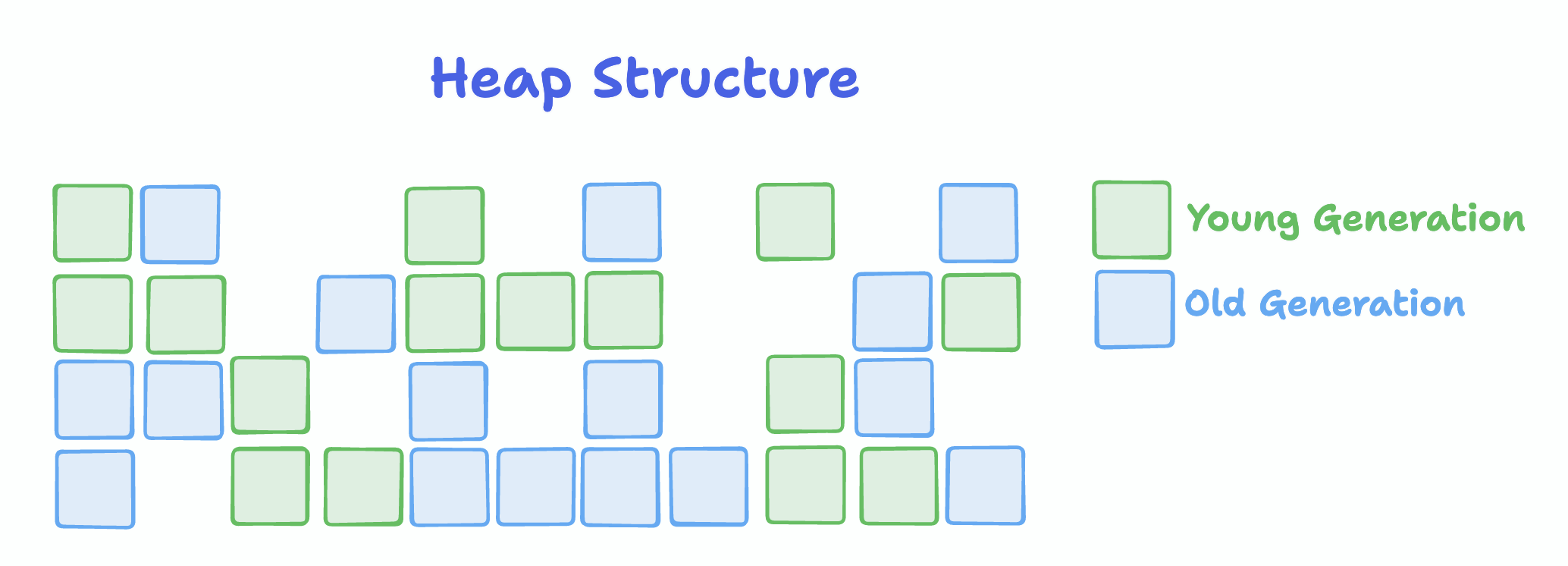
At some cases, If an object requires larger and equal the size of a half region, this type of object gets allocated as sequence of several regions. This objects are called Humongous Objects .
G1 concentrates efforts on regions of Young Generation and checks regions of Old Generation occasionally. After initial mark the Garbage Collector pick the regions that will yield a large amount of free space. This approach lets the garbage collector be most effective. That’s why it is called Garbage First - blocks with garbage will be handled first.
After each Young Generation Collection, all remaining live objects are evacuated and compacted to an available region of Young Generation or if the threshold is met, objects are moved to a region of Old Generation accordingly.
The following flags might be used to tune G1 settings:
java \
-XX:+UseG1GC # enable Garbage First Collector
-XX:MaxGCPauseMillis=<N> # Maximum interval between GC pauses
-XX:GCPauseIntervalMillis=<N> # Maximum interval between G1 executions
-XX:G1HeapRegionSize=<size>[k|m|G] # heap memory size
-XX:ParallelGCThreads=<N> # count of threads for parallel GC execution
-XX:ConcGCThreads=<N> # total count of threads for GC
Links:
- HotSpot Virtual Machine Garbage Collection Tuning Guide
- Getting Started with the G1 Garbage Collector
ZGC - The Z Garbage Collector
This garbage collector targets to provide low latency, less 10ms and to work with multi-terabytes heap. It guarantees O(1) pause duration.
In case of big capacity of heap, a phase with moving objects and compaction takes too much time. Moreover it requires suspending application threads, in order to change references to new locations of relocated objects. ZGC solves this problem concurrently without stop-the-world pause. The trick that lets Z Garbage Collector do it is load GC barriers and coloured references.
There are 3 stages of GCs work:
- Concurrent Mark - identify objects as reachable
- Concurrent Relocate - to avoid memory fragmentation or promote object to Old Generation, move objects to another region
- Concurrent Remap - change references to new locations of evacuated objects.
All these stages are performed without stop-the-world pause, thus application threads are not suspended. Let’s look at how it might be done. 64-bit architecture provides 64 bits for memory addressing. However, not all 64 bits are used. Only 42 bits are used for addressing. By this way, other bits might store meta information. Coloured References are references where 4 bits are used by ZGC.

Finalizable Bit means that object is available through a finalizer Remapped Bit denotes that reference is up to date and points to the current location Marked 0 and Marked 1 bits are used to mark reachable objects.
Load GC barrier is a piece of code injected by JIT Compiler for all references. Each time when ZGC traverse the reference graph or application thread loads a variable through a reference, a load GC barrier checks a coloured reference and there can be 2 cases:
- if Remapped bit is 0 then variable might be loaded without any additional actions safely.
- otherwise there are following actions must be done
- reference colour must be fixed
- some actions must be done with the object atomically depends on the current stage of Garbage Collector, e.g. moving object to another location, change reference to a new location etc.
Like in case of G1 Collector, there are generational regions but have different size. 2 phases:
- Minor Collection happens when ZGC works with Young Generation.
- Major Collection - the Garbage Collector works with both generations.
As we can see we pays additional cost for loading references but this cost is not huge and it might be a trade-off between slight decreasing of application performance and extremely low GC pauses.
The following command is used to enable the ZGC:
java \
-XX:+UseZGC # enable ZGC
-XX:+ZGenerational # Generational ZGC is enabled
Links:
- HotSpot Virtual Machine Garbage Collection Tuning Guide
- [VDT19] Concurrent Garbage Collectors: ZGC & Shenandoah by Simone Bordet [IT]
- The Z Garbage Collector (ZGC)
ShenandoahGC
This garbage collector is available in RedHat OpenJDK & AdoptOpenJDK builds. It uses the same approach like Z Garbage Collector. The notable difference between two garbage collectors is ShenandoahGC works also on 32-bit architecture.
Instead of using Coloured references, ShenandoahGC stores metadata in HostSpot Object Header. The header involves Forward Pointer that points to a current location or a new location of objects after performing relocate stage. The garbage collector alike ZGC uses Load GC Barriers. The logic of work is the same - to check the current phase of the GC work and to perform some actions depends on the phase or just to follow to the point.
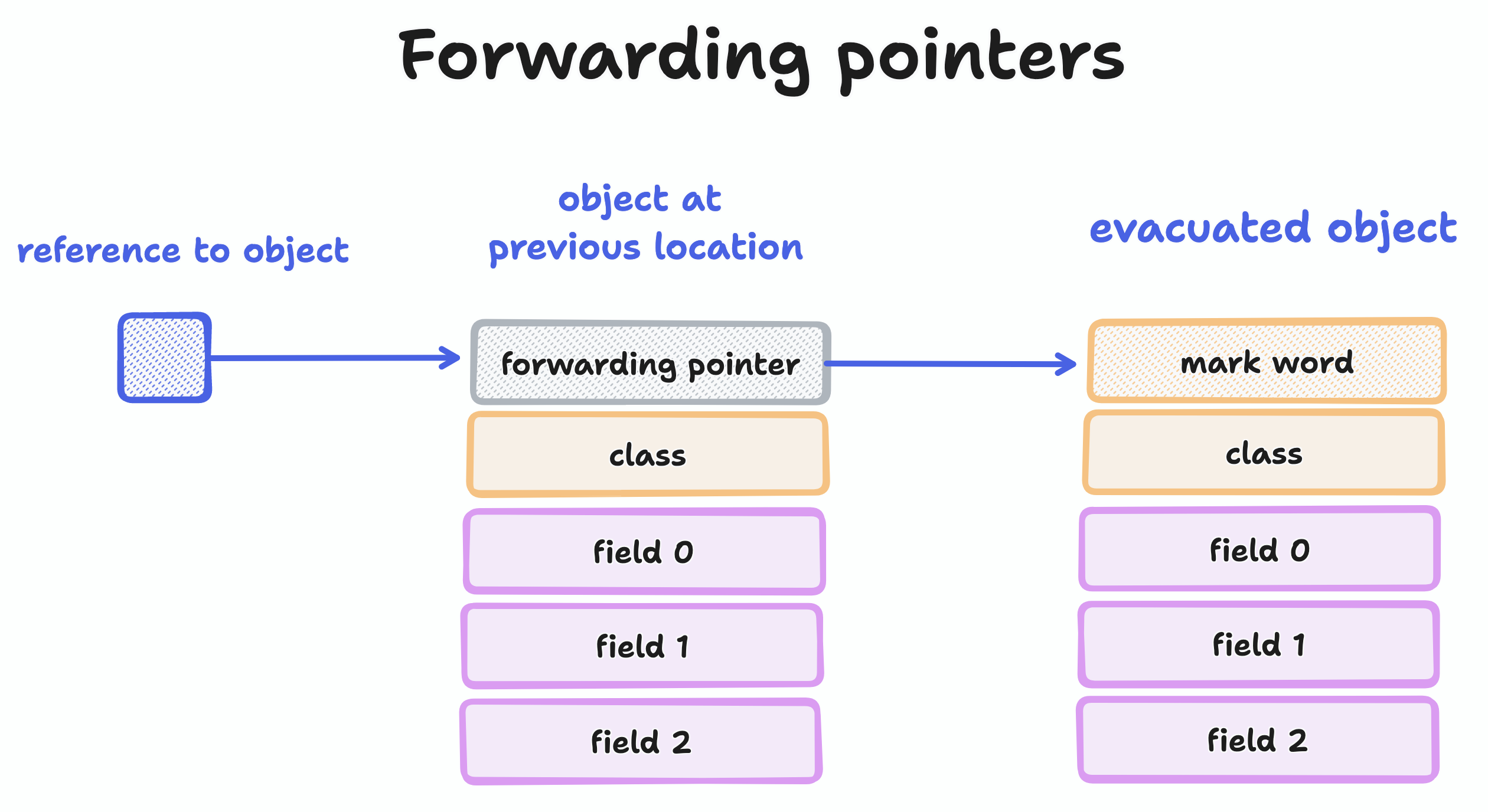
There are 3 stages of the GC work:
- Concurrent Mark - mark all reachable objects as alive
- Concurrent Evacuation - move live objects to new regions or compact them
- Concurrent Update References - update references to new location All these stages might be merged into one. It is called Traversal Mode.
To use this ShenandoahGC, enable the JVM flag below:
java
-XX:+UseShenandoahGC # enable Shenandoah Garbage Collector
Links:
Azul C4 Garbage Collector
The full name of GC is Continuously Concurrent Compacting Collector, or shortly C4. This Garbage Collector might be used with Azul Zulu Builds of OpenJDK. It is generational pauseless GC. It uses read barrier called The Loaded Value Barrier (LVB). Like ZGC stores metadata in unused bits of references. It’s field named Not Marked Through state. Each time when reference is loaded, the barrier checks the field and if additional actions are needed, they are applied. There are 3 phases of C4 algorithm.
- Marking - mark all reachable objects
- Relocation - move objects in order to free up larger consequent memory regions.
- Remapping - change the references to a new location of relocated objects.
Links:
- C4: The Continuously Concurrent Compacting Collector
- Azul C4 Garbage Collector
- Really Understanding Garbage Collection Gil Tene Talk QCon SF 2019
- JVM performance optimization, Part 4: C4 garbage collection for low-latency Java applications
Epsilon Garbage Collector
This garbage collector is pretty simple in comparison to the mentioned earlier ones. It doesn’t collector garbage. With enabled Epsilon GC sooner or later java.lang.OutOfMemoryError occurs. For sure, if you don’t have infinite capacity of RAM or your program doesn’t allocate new objects at all. At some case, it might be a good option, if latency is important and overhead from a garbage collector is not acceptable e.g. microbenchmarking, garbage free or short-running programs.
With following flags you can enable this Epsilon Garbage Collector:
java \
XX:+UnlockExperimentalVMOptions # unlock experimental features
-XX:+UseEpsilonGC # enable Epsilon Garbage Collector